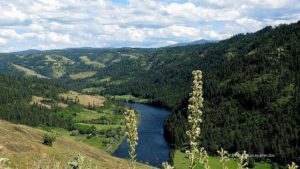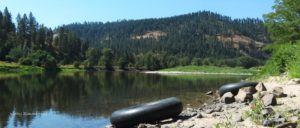HISTORY
Nestled amid protective hills at the confluence of the Southfork and Middlefork of the Clearwater River lies the city of Kooskia (Pronounced Koos-kee). Lumber production, farming, cattle raising, logging, and tourism are the major industries of the Kooskia area.
The Lewis-Clark Highway (US 12), which parallels the route of the famous explorers, Lewis and Clark, passes through the rugged Lochsa Canyon. Kooskia was named for what is now the Clearwater River. The Nez Perce called it Koos-Koos-Kia for the river’s transparent quality. The townsite was surveyed in 1897 and was originally known as Stuart. There was a tram from Kooskia’s flour mill to the Camas Prairie grain fields from 1903 to 1939. The tramway had two cables running the entire length of a mile and a quarter which carried thirty buckets.
The town of Kooskia was established in 1895 when the government set aside 104 acres for townsite purposes. Kooskia began its existence as Stuart when the townsite was surveyed in 1897. The town was first named for James Stuart, a Nez Perce surveyor and merchant.
The Post Office was established as Stuart on May 25, 1896. The first newspaper, called the Alta Idaho Area Paper, was printed January 1, 1898. On April 16, 1902, the first issue of the Kooskia Mountaineer was off the press.
The railroad track was laid into Kooskia on March 13, 1900. In 1900, the town was called Stuart, but the train depot was called Kooskia, as dubbed by the railroad. The town changed its name from Stuart to Kooskia to coincide with the railroad depot on April 14, 1902. The town name is a contraction of the Koos-koos-kia, meaning “where the waters meet.” This name appears in the journals of Lewis and Clark in 1805 to designate the river now called the Clearwater River.
Kooskia lies in two areas along the Southfork and the Middlefork of the Clearwater River separated by a “hogback,” an extension of Mount Stuart. The area along the Middlefork was designated for the natives and the area along the Southfork for the new settlers.
Kooskia was known among western horsemen, during the 1900’s as the home of the Decker saddle. The saddle was developed by Oliver P. Robinett, a blacksmith, and packer in 1906. Some accounts also credit Robinett for the Polaski, a mattock-axe tool that is standard equipment for forest fire crews.


